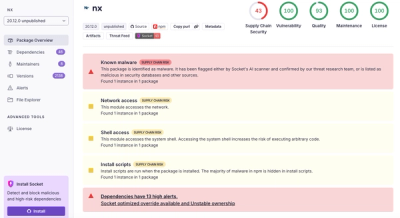
Security News
/Research
Wallet-Draining npm Package Impersonates Nodemailer to Hijack Crypto Transactions
Malicious npm package impersonates Nodemailer and drains wallets by hijacking crypto transactions across multiple blockchains.
This is a CLI tool for linting codebases using eslint-config-mic. You can run it like this:
# normal
miclint
# with support for flow types
miclint --flow
# to fix easy problems
miclint --fix
If you would prefer a more custom setup, you can integrate eslint-config-mic into your existing eslint setup For more information on that, go here.
Download node at nodejs.org and install it, if you haven't already.
npm install miclint --save-dev
npm install
npm test
None
MIT
Generated by package-json-to-readme
FAQs
Mic lint CLI
The npm package miclint receives a total of 244 weekly downloads. As such, miclint popularity was classified as not popular.
We found that miclint demonstrated a not healthy version release cadence and project activity because the last version was released a year ago. It has 6 open source maintainers collaborating on the project.
Did you know?

Socket for GitHub automatically highlights issues in each pull request and monitors the health of all your open source dependencies. Discover the contents of your packages and block harmful activity before you install or update your dependencies.

Security News
/Research
Malicious npm package impersonates Nodemailer and drains wallets by hijacking crypto transactions across multiple blockchains.

Security News
This episode explores the hard problem of reachability analysis, from static analysis limits to handling dynamic languages and massive dependency trees.

Security News
/Research
Malicious Nx npm versions stole secrets and wallet info using AI CLI tools; Socket’s AI scanner detected the supply chain attack and flagged the malware.